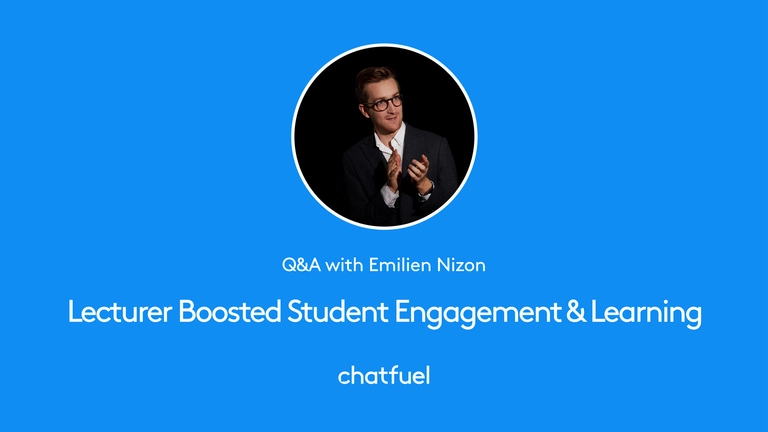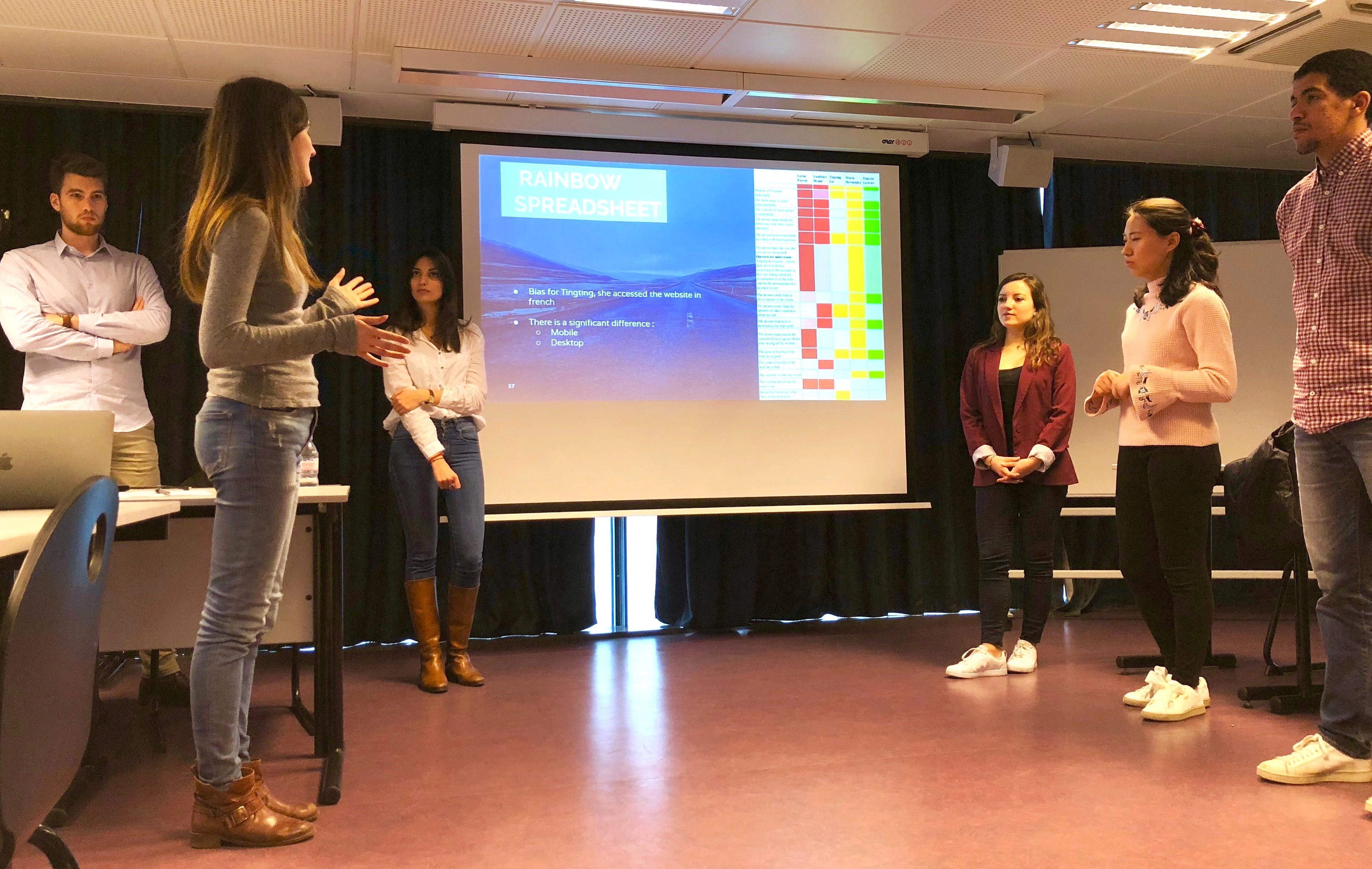
University lecturer accelerated student learning with a bot
Get inspired by the story of Emilien Nizon: how he boosted student engagement and accelerated their learning with Chatfuel Messenger chatbot
Emilien Nizon has been lecturing at leading business schools in France and abroad for six years, some of which include KEDGE in Marseille, Audencia in Nantes, and Skema in Paris. He has also served as a consultant to help other educators improve student experience and satisfaction.
Nizon came up with the idea to implement a Messenger chatbot to act as a course companion for 2,000+ of his master’s program students. What began as a small experiment turned into a powerful tool that revolutionized student learning outcomes and satisfaction levels.
“Conversational learning via bots represents an entirely new chapter in the evolution of how we educate young people.”
We’re excited to share Emilien’s chatbot use case to illustrate how bots can be used for more than just business applications. Here’s his story.
Where did you get the idea to incorporate technology into your classes?
I built my career as a product manager, working in diverse industries from music streaming to e-commerce and travel. For the past six years, however, I’ve been a university lecturer at leading business schools here in France and abroad. I also do consulting work with educators to help improve student experience and satisfaction, a topic I’m highly passionate about.
I’ve had thousands of students pass through my classes over the last several years, and my aim is always to find ways to better facilitate their learning. Over time, I began to notice that the more interactive I made my classes, the more my students would enjoy and absorb the material. I suspected that incorporating technology was the way forward with this, so I decided to run an experiment. I donned my product-manager hat and planned an A/B test to quantify my observation and see where it led.
I kept a normal classroom environment with the control group of students, allowing them to participate by raising their hand or taking quizzes on paper at the end of a lecture. With the test group of students, however, I encouraged the use of a mobile service to ask questions and take the quizzes instead. It was a simple test, but the results clearly showed that both satisfaction and participation levels were higher in the test group. I knew I was on to something—so that’s when I decided to build a bot and to name it Ed.
What is Ed, and how does it work?
I knew I wanted to make my classes more interactive and impactful using technology, and chatbots had appeared on my radar as a potential way to do that. I didn’t know of anyone who was already using a bot as a teaching tool, so I decided to try creating one myself. In March 2017, I set out to build the first version of Ed, a chatbot designed to act as an aid and course companion for my students.
Drawing from my past experience as a product manager, I first built an MVP (minimum viable product) version of Ed as test. It was only able to recognize a few basic words, and it offered just two main functions.
- Live chat. First, Ed allowed students to chat with me directly thanks to the Live Chat plugin. I found this feature particularly handy for communicating with shy students who may not have approached me otherwise.
- Presentation feedback. I also equipped the bot to share my feedback on each student’s final presentation, so they could access it quickly and easily within Messenger.
Then in January 2018, I introduced a new, 18-hour program called User Research at SKEMA in France. I saw the opportunity to push my simple bot further—to integrate it into the coursework and to introduce two more features:
- Class resources. One additional feature I implemented was to have the chatbot share documents and articles referenced in class, so students could access them any time. I used the Set Up AI tab in Chatfuel (which now lives under the Automation tab) to allow students to enter keywords and receive relevant resources in return.
- Push notifications. Using the Reengage tab in Chatfuel, I created inspirational messages (“Today is presentation day—good luck!”), instructions and reminders (“Don’t forget: Log into your course portal to submit your assignment by midnight”), or alerts (“Your presentation feedback is ready! Tap to view.”)

How did you measure if the updated version of Ed was a success or not?
A few months after releasing the new version of Ed, the product manager in me knew I needed to gather data to decide whether it was helping or hindering my students. Did they all have Messenger, so they could access the bot in the first place? Were they actually using Ed and finding it beneficial, or was it seen as a cumbersome and unhelpful add-on?
My personal experiences with bots as a user in the past were often disappointing, as they generally seemed to add more complexity to a task, not less. I wanted to make sure Ed wasn’t causing this same issue for students.
Though my students seemed to be benefiting from the bot, I wanted hard data to know for sure. To gauge whether Ed was making an impact, and whether it was worth further development, I sent out the following questions in a web survey:
- How satisfied were you with Ed, the educational chatbot?
- Did you find that interacting with Ed during class improved your educational experience?
- Would you appreciate seeing chatbots used in more classes?
I released a link to this simple survey to everyone who had experienced Ed so far—over 1,200 international students from various business schools where I lectured. The results came in quickly, and they were astounding.
How did students rate their experience with Ed?
Within a few hours, 737 students responded to the survey—and the results were overwhelmingly positive! 99% of respondents declared being satisfied with Ed, and 62% of those reported being “very satisfied.”
Nearly 90% of students said they found that interacting with Ed improved their educational experience. Most interestingly, an incredible 98% shared that they’d like to see chatbots used in more classes, with 63% of those expressing interest in having chatbots incorporated into all of their classes.

“Nearly 90% of students said they found that interacting with Ed improved their educational experience. Most incredibly, 98% shared that they’d like to see chatbots used in more classes […]”
The students’ responses proved that Ed was a worthwhile project, and the data gathered about it from Chatfuel did too. When students were given the option for in-class participation via bot, the interactivity rate was almost 100%. Plus, 100% of messages Ed sent to students at any time were read, and 90% of those were viewed within one hour. The data showed me that messages from a bot promote astronomically higher rates of interaction and engagement, especially when compared to traditional, tech-free lectures or email messages.
“Plus, 100% of messages Ed sent to students at any time were read, and 90% within one hour.”
How else has Ed impacted you and your students?
Chatbots are a new and exciting type of technology, and they spark the curiosity of my students. The fact they can receive helpful information instantly with a few taps allows them to become more engaged, active participants in their education, rather than passively reading static emails or listening to lectures without taking part. Thanks to Ed, our classroom sessions have become more dynamic and the students’ final presentations have even improved in quality. So not only are my students enjoying their educational experience more with the bot, but they’re getting more out of it, too.

It isn’t just my students who benefit from Ed, either; after its implementation, I found that I spent less time answering student emails. They began submitting their questions through the bot instead, which allowed me to answer more quickly and from anywhere — if needed.
Overall, I’ve been able to see a measurable impact on student satisfaction rates and educational outcomes, which are my key metrics. Because of Ed, students are now more involved, and have an easier time comprehending course content. As a result, they’re able to apply the concepts they’ve learned more successfully, and they report higher levels of course satisfaction too. They’re getting more out of their education and they realize it, which has always been my central goal as a lecturer.
“Overall, I’ve been able to see a measurable impact on student satisfaction rates and educational outcomes, which are my key metrics.”
Now, students in my classes get to know Ed just as they get to know me! Within the first ten minutes of the very first class, I introduce them to Ed and explain how it functions as a constantly available course companion. I also guide them through the steps to add Ed to Messenger, as many of them have never added a chatbot there. The process is seamless, and it allows me to set my students up for success immediately.
Why did you choose Chatfuel to build your bot?
When I set out to build the first version of Ed, I had benchmarked a few different chatbot solutions. Chatfuel, however, immediately stood out as the most reliable and fully loaded. Testing it out and seeing that I could have a functioning bot in five minutes was what really won me over.
My priorities in searching for the right bot-building platform were stability and a great end-user experience, and Chatfuel delivered on both. Testing the first version of Ed live in class after just a few clicks was easy for me and exciting for my students. That’s when I knew Chatfuel was the right choice for this project. The fact that I can make changes to my bot in Chatfuel and deploy them instantly is important to me too. I can adapt quickly and modify the bot experience on the fly, which allows me to constantly iterate and improve the chatbot for my students.
“Testing [Chatfuel] out and seeing that I could have a functioning bot in five minutes was what really won me over.”
Which Chatfuel features have been most important to Ed’s success?
User attributes is probably the feature that’s been most crucial. These customizable tags let me provide the right content to students at the right time. For example, I can set up an attribute for which school a user attends and which program they’re in.
I also use attributes to reflect a student’s progress in the course. That way, they’re able to “unlock” content as they move forward, which game-ifies the experience to make it even more engaging. Essentially, this feature allows me to easily categorize thousands of students based on their inputs, and have Ed follow up with the appropriate actions. I also look forward to using Ed as a research tool in the future. I’ve been experimenting with the Google Sheets integration, and plan to use it to aggregate and analyze student responses. It’s just another way Ed will help me learn more about my students’ needs so I can provide an even more personalized and effective learning experience for them.
Have you worked with any other educational bots?
I firmly believe that interactivity is key to positive educational outcomes. The world is changing, technology is expanding, and educators now have so many new tools to improve and update the way we teach. I’ve yet to come across others putting chatbots to use in the classroom, which is exactly why I’ve started consulting with schools and educators—to help them push the student experience further.
What’s next for your work with Ed?
In addition to the consulting work I do, I’ve also begun sharing my knowledge about bots in a different way. Not only do I provide Ed as a tool for my students to use, but I now teach them how to harness this type of technology themselves, too. A common theme in my coursework is breaking the perception that something is “too hard” or “too different” for students to learn, and I start with my own experiences as a product manager turned lecturer to illustrate this.
“Not only do I provide Ed as a tool for my students to use, but I now teach them how to harness this type of technology themselves too.”
I like to integrate chatbot building into the coursework itself to show students that they can create bots, too. Not only are they interested in the process, but it gives them an instant confidence boost. Some even go on to make their own bots in the future. I’m proud to be able to demystify this new technology, and show them how much they can do with the right tools.
The potential for even more educational applications of chatbots is thrilling to me. I’ve seen incredible results with Ed so far, and I look forward to creating even more positive outcomes with bots for my students in the future. Conversational learning via bots represents an entirely new chapter in the evolution of how we educate young people. I can’t wait to experiment more with chatbots, and help other educators begin to do the same.

Are you an educator or instructor interested in implementing a bot for your students? You’re in the right place! Getting started with Chatfuel is free, and no programming or coding skills are required. Discover the power of the newest educational tool by building your own bot today!
